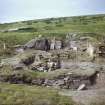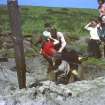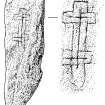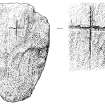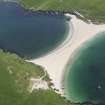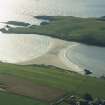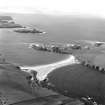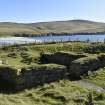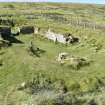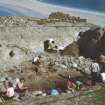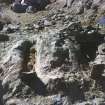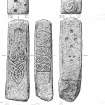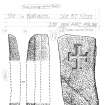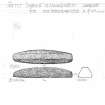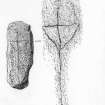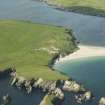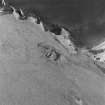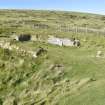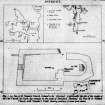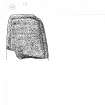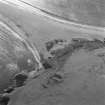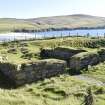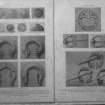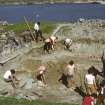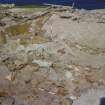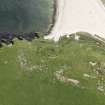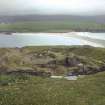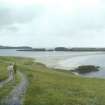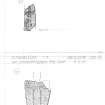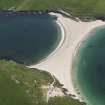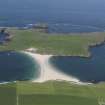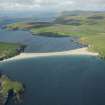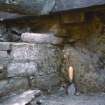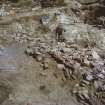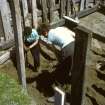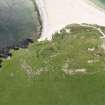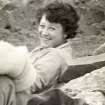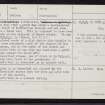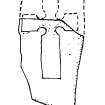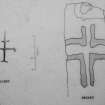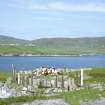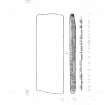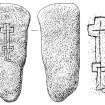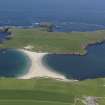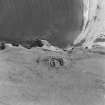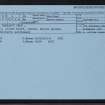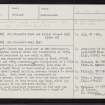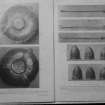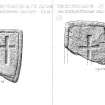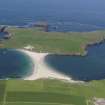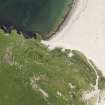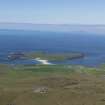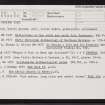St Ninian's Isle
Burial Ground (Medieval), Church (12th Century), Composite Slab Shrine (Early Medieval), Ogham Inscribed Stone (Early Medieval), Settlement (Iron Age), Well (Medieval), Hoard (Silver)(Early Medieval)
Site Name St Ninian's Isle
Classification Burial Ground (Medieval), Church (12th Century), Composite Slab Shrine (Early Medieval), Ogham Inscribed Stone (Early Medieval), Settlement (Iron Age), Well (Medieval), Hoard (Silver)(Early Medieval)
Alternative Name(s) St Ninian's Kirk And Burial-ground
Canmore ID 587
Site Number HU32SE 4
NGR HU 3685 2090
Datum OSGB36 - NGR
Permalink http://canmore.org.uk/site/587
- Council Shetland Islands
- Parish Dunrossness
- Former Region Shetland Islands Area
- Former District Shetland
- Former County Shetland
St Ninian’s Isle 1, Shetland, ogham-inscribed fragment
Measurements: H 0.78m, W 0.26m, D 0.05m
Stone type: pale sandstone
Place of discovery: HU 3685 2090
Present location: National Museums Scotland, Edinburgh (IB.112)
Evidence for discovery: found ‘imbedded in the sand’ on the chapel site by Gilbert Goudie in 1876.
Present condition: the narrow ends of the slab are broken and the broad surfaces are laminated, but the ogham letters are clear.
Description
This is a rectangular slab on which ogham letters on a stem line have been carved along one long narrow face. The ogham inscription includes personal names and may be relatively early.
Goudie found two other fragments of ogham inscriptions but does not describe them and left them on site.
Date: eighth or ninth century.
References: Goudie 1878; Forsyth 1996, 467-79; Scott & Ritchie 2009, no 48; Forsyth 2011.
Compiled by A Ritchie 2016
St Ninian’s Isle 11, Shetland, cross-slab
Measurements: H 0.32m, W 0.30m, D 0.05m
Stone type: steatite
Place of discovery: HU 3685 2090
Present location: Shetland Museum, Lerwick (ARC 6641)
Evidence for discovery: found during the 1956-9 excavations, exact provenance unknown.
Present condition: good apart from some damage to the left-hand lower corner.
Description
This slab has a pecked line all round the carved face, suggesting that this was a recumbent gravemarker. It bears a well-carved sunken cross.
Date: ninth or tenth century.
References: Thomas 1973, no 13; Scott & Ritchie 2009, no 61.
Compiled by A Ritchie 2016
St Ninian’s Isle 12, Shetland, cross-slab fragment
Measurements: H 0.43m +, W 0.45m, D 0.08m
Stone type: steatite
Place of discovery: HU 3685 2090
Present location: Shetland Museum, Lerwick (ARC 67129)
Evidence for discovery: found during excavation in 1956, lying face up in the west end of the nave of the medieval church.
Present condition: broken
Description
This is the upper part of a cross-slab with a sunken cross and a flatband border creating by a pecked line.
Date: ninth or tenth century.
References: Thomas 1973, no 14; Scott & Ritchie 2009, no 62.
Compiled by A Ritchie 2016
St Ninian’s Isle 13, Shetland, cross-slab fragment
Measurements: H 0.41m, W 0.37m, D 0.07m
Stone type: steatite
Place of discovery: HU 3685 2090
Present location: Shetland Museum, Lerwick (ARC 67130)
Evidence for discovery: found during the excavation, possibly in 1956, lying face up in the south-west part of the nave of the medieval church.
Present condition: broken.
Description
This fragment is plain apart from a pecked line creating a flatband moulded frame. It may be the base of a recumbent slab like no 12.
Date: ninth or tenth century.
References: Thomas 1973, no 12; Scott & Ritchie 2009, no 64.
Compiled by A Ritchie 2016.
St Ninian’s Isle 14, Shetland, cross-slab fragment
Measurements: H 0.36m +, W 0.23m, D 0.01m
Stone type: sandstone
Place of discovery: HU 3685 2090
Present location: Shetland Museum, Lerwick (ARC 6640)
Evidence for discovery: found during excavation in 1958 in the nave of the medieval church, lying face down over the silver hoard, presumably re-used.
Present condition: broken.
Description
Only the lower edges of this slab are intact, bearing the shaft and part of the head of an incised outline cross. The incision is neat and exact, and the cross has a squared terminal to the surviving side-arm, and large rounded armpits.
Date: eighth century.
References: Thomas 1973, no 15; Scott & Ritchie 2009, no 66.
Compiled by A Ritchie 2016
St Ninian’s Isle 15, Shetland, cross-slab fragments
Measurements: H 0.43m, W 0.21m, D 0.03m
Stone type: sandstone
Place of discovery: HU 3685 2090
Present location: Shetland Museum, Lerwick (ARC 1993.120)
Evidence for discovery: found during excavation in 1959, lying face down in the south-west part of the nave of the medieval church.
Present condition: fractured with broken edges.
Description
This is a very informal cross-slab, lightly incised with a cross with barred terminals and an extra bar across the upper arm.
Date: eighth or ninth century.
References: Thomas 1973, no 10; Scott & Ritchie 2009, no 68.
Compiled by A Ritchie 2016
St Ninian’s Isle 16, Shetland, cruciform gravemarker fragment
Measurements: H 0.14m +, W 0.20m, D 0.03m
Stone type: steatite
Place of discovery: HU 3685 2090
Present location: Shetland Museum, Lerwick (ARC 6642)
Evidence for discovery: found during the 1950s excavations but exact provenance unknown.
Present condition: broken, with part of one side-arm and the shaft missing.
Description
This is part of an unusually small but nonetheless carefully carved cruciform stone.
Date: tenth century.
References: Thomas 1973, no 16; Scott & Ritchie 2009, no 81.
Compiled by A Ritchie 2016
St Ninian’s Isle 17, Shetland, hogback gravemarker
Measurements: L 1.14m, W 0.14m to 0.26m, H 0.10m to 0.20m
Stone type: steatite
Place of discovery: HU 3685 2090
Present location: Shetland Museum, Lerwick (ARC 67123)
Evidence for discovery: found during excavations in 1957, outside the west wall of the medieval chapel.
Present condition: some wear.
Description
This gravemarker has the classic hogback profile but lacks any tegulation, instead it has a raised flat band along its ridge.
Date: eleventh or twelfth century.
References: Thomas 1973, no 17; Scott & Ritchie 2009, no 126.
Compiled by A Ritchie 2016
St Ninian’s Isle 18, Shetland, portable cross-slab
Measurements: H 245mm, W 104mm, D 22mm
Stone type: micaceous schist
Place of discovery: HU 3685 2090
Present location: Shetland Museum, Lerwick
Evidence for discovery: found during excavations in 1999-2000 of the long cist cemetery south of the chapel.
Present condition: some wear.
Description
This small slab is incised with a plaited double cross, and there is some indication that the shaft may have ended in a triquetra knot.
Date: eighth or ninth century.
References: Scott & Ritchie 2009, no 71; Fisher 2011, SF 301, 121, 123.
Compiled by A Ritchie 2016
St Ninian’s Isle 19, Shetland, portable cross-slab
Measurements: H 197mm, W 74mm, D 12mm
Stone type: micaceous schist
Place of discovery: HU 3685 2090
Present location: Shetland Museum, Lerwick
Evidence for discovery: found during excavations in 1999-2000 of the long cist cemetery south of the chapel.
Present condition: worn.
Description
This small slab is incised lightly and not very expertly with a long-shafted Latin cross, on which two curving lines run from part way down the shaft towards the ends of the side-arms..
Date: eighth or ninth century.
References: Scott & Ritchie 2009, no 72; Fisher 2011, SF 433, 122, 123.
Compiled by A Ritchie 2016
St Ninian’s Isle 20, Shetland, portable cross-slab
Measurements: H 207mm, W 63mm, D 18mm
Stone type: micaceous schist
Place of discovery: HU 3685 2090
Present location: Shetland Museum, Lerwick
Evidence for discovery: found during excavations in 1999-2000 of the long cist cemetery south of the chapel.
Present condition: worn.
Description
This slender slab is incised lightly with a plaited double cross.
Date: eighth or ninth century.
References: Scott & Ritchie 2009, no 70; Fisher 2011, SF 465, 121, 123.
Compiled by A Ritchie 2016
St Ninian’s Isle 2, Shetland, shrine post
Measurements: H 0.81m, W 0.41m, D 0.32m
Stone type: sandstone
Place of discovery: HU 3685 2090
Present location: Shetland Museum, Lerwick (ARC 6685)
Evidence for discovery: found during excavation in 1957 in the rectangular structure dubbed the ‘Founder’s Tomb’.
Present condition: worn with some edge damage.
Description
A dressed rectangular post, this has three decorated faces and two grooved faces. The grooves are 0.64m long. The two vertical decorated faces have plain flatband borders formed by pecked lines: Face A bears two opposed and intertwined S-dragons above a double triquetra knot, while face D bears six double spirals set in a continuous panel one above the other. Face E, the top of the post, bears three small hollows.
Date: eighth or ninth century.
References: Thomas 1973, no 1; Scott & Ritchie 2009, no 31.
Compiled by A Ritchie 2016
St Ninian’s Isle 21, Shetland, cross-slab
Measurements: H 0.62m, W 0.36m, D 0.04m
Stone type: micaceous schist
Place of discovery: HU 3685 2090
Present location: Shetland Museum, Lerwick
Evidence for discovery: found during excavations in 1999-2000 of the long cist cemetery south of the chapel, face up covering the east end of a long cist.
Present condition: good.
Description
This unshaped slab is incised with a simple Latin cross.
Date: eighth century.
References: Scott & Ritchie 2009, no 69; Fisher 2011, SF 494, 122, 123.
Compiled by A Ritchie 2016
St Ninian’s Isle 10, Shetland, cross-slab
Measurements: H 1.00m, W 0.36m, D 0.09m
Stone type: sandstone
Place of discovery: HU 3685 2090
Present location: fixed to the wall inside Bigton Kirk.
Evidence for discovery: found during excavation in 1956, lying face down against the inner face of the south wall of the medieval chapel. It was taken to St Ninian’s Kirk at Bigton on the adjacent mainland.
Present condition: some wear and the base is broken.
Description
This rectangular slab is incised with an outline cross with slightly expanded upper arm and the side-arms almost reaching the sides of the slab
Date: eighth or ninth century.
References: Thomas 1973, no 18; Scott & Ritchie 2009, no 56.
Compiled by A Ritchie 2017
St Ninian’s Isle
A tiny island off the west coast of Shetland hosted an important early church of which traces have been found by excavation. Its collection of carved stones includes 16 cross-slabs, three portable cross-incised stones and an ogham-inscribed fragment. There is also one cruciform slab and an unusually small hogback gravestone, perhaps to mark a child’s grave, and these indicate Norse influence. In addition to these personal memorials, the presence of seven grooved stone posts testify to the use of at least two shrine-chests composed of side-panels slotted into corner-posts, which would have housed relics of saints or perhaps revered local aristocrats.
Primary references: Barrowman 2003; Scott & Ritchie 2009; Barrowman 2011.
A Ritchie 2019
St Ninian’s Isle 3, Shetland, shrine post
Measurements: H 0.84m, W 0.21m, D 0.14m
Stone type: sandstone
Place of discovery: HU 3685 2090
Present location: Shetland Museum, Lerwick (ARC 6686)
Evidence for discovery: found during excavation in 1957, in a secondary context set upright in the north-east corner of the rectangular structure dubbed the ‘Founder’s Tomb’.
Present condition: worn.
Description
The upper part of this post is dressed while the basal portion has been left rough. It has two decorated faces, A and E, and three grooved faces. The grooves are 0.37m to 0.52m long. Face A has a plain flatband border formed by a pecked line, within which are seven hollows: a group of four hollows above a group of three smaller hollows. The top, face E, has a circular boss, 0.13m in diameter, carved in relief with a triple spiral.
Date: eighth or ninth centuries.
References: Thomas 1973, no 2; Scott & Ritchie 2009, no 32.
Compiled by A Ritchie 2016
St Ninian’s Isle 4, Shetland, shrine post
Measurements: H 0.89m, W 0.23m, D 0.15m
Stone type: sandstone
Place of discovery: HU 3685 2090
Present location: Shetland Museum, Lerwick (ARC 6684)
Evidence for discovery: found during excavation in 1957 in the rectangular structure dubbed the ‘Founder’s Tomb’.
Present condition: very worn.
Description
The upper part of this post is dressed while the basal portion has been left rough. It has three decorated faces, A, B and E, and two grooved faces. The grooves are 0.55m long. The two vertical decorated faces have plain flatband borders formed by pecked lines: face A bears two opposing S-dragons with crossed fore-legs and spiral tails, above a double spiral, while face B is carved partly in relief with three continuous triple spirals. Face E, the top of the post, is carved in relief with an oblong boss which is very worn but may once have borne decoration.
Date: eighth or ninth century.
References: Thomas 1973, no 3; Scott & Ritchie 2009, no 34.
Compiled by A Ritchie 2016.
St Ninian’s Isle 5, Shetland, shrine post
Measurements: H 0.78m, W 0.22m, D 0.26m
Stone type: sandstone
Place of discovery: HU 3685 2090
Present location: Shetland Museum, Lerwick (ARC 67121)
Evidence for discovery: found during excavation in 1957 in the rectangular structure dubbed the ‘Founder’s Tomb’.
Present condition: very worn.
Description
This rectangular post has two decorated faces, A and E, and three grooved faces. The grooves are 0.38m to 0.56m long. Face A is very worn but appears to retain traces of diagonal interlace within a flatband border formed by a pecked line. Face E has an oblong boss carved in relief, now plain.
Date: eighth or ninth century.
References; Thomas 1973, no 4; Scott & Ritchie 2009, no 33.
Compiled by A Ritchie 2016
St Ninian’s Isle 6, Shetland, shrine post
Measurements: H 0.52m +, W 0.20m, D 0.12m
Stone type: sandstone
Place of discovery: HU 3685 2090
Present location: Shetland Museum, Lerwick (ARC 67120)
Evidence for discovery: found during excavation in 1957, in a secondary context set upright in the north-east corner of the rectangular structure dubbed the ‘Founder’s Tomb’.
Present condition: very worn and battered and broken at the base.
Description
This post has four decorated faces, one of which is also grooved, and one other grooved face. The grooves are about 0.40m long. Within flatband borders created by pecked lines the ornament consists on face A of a double cross carved in false relief with a pellet between the arms of the upper cross and on the shaft of the lower, on face C (above the groove) of an inurned pair of spirals and on face D of a panel of faint interlace. The top of the post, face E, bears an oblong boss, now plain.
Date: eighth or ninth century.
References: Thomas 1973, no 5; Scott & Ritchie 2009, no 44.
Compiled by A Ritchie 2016
St Ninian’s Isle 7, Shetland, shrine post
Measurements: H 0.73m, W 0.12m, D 0.18m
Stone type: sandstone
Place of discovery: HU 3685 2090
Present location: Shetland Museum, Lerwick (ARC 67125)
Evidence for discovery: found during excavation in 1957 in the rectangular structure dubbed the ‘Founder’s Tomb’.
Present condition: good.
Description
This is a plain post with a naturally rough base and three grooved faces, the grooves being 0.25m to 0.30m long.
Date: eighth or ninth century.
References: Thomas 1973, no 8; Scott & Ritchie 2009, no 45.
Compiled by A Ritchie 2016
St Ninian’s Isle 8, Shetland, shrine post fragment
Measurements: H 0.38m, W 0.23m, D 0.11m
Stone type: sandstone
Place of discovery: HU 3685 2090
Present location: Shetland Museum, Lerwick (ARC 67124)
Evidence for discovery: found during excavation in 1957 in the rectangular structure dubbed the ‘Founder’s Tomb’.
Present condition: broken and battered.
Description
This fragment represents the upper portion of a plain and substantial post, with grooves in two faces.
Date: eighth or ninth century.
References: Thomas 1973, no 9; Scott & Ritchie 2009, no 47.
Compiled by A Ritchie 2016
St Ninian’s Isle 9, Shetland, cross-slab
Measurements: H 0.64m, W 0.10m, D 0.06m
Stone type: micaceous metaquartzite
Place of discovery: HU 3685 2090
Present location: Shetland Museum, Lerwick (ARC 6643)
Evidence for discovery: found during excavations in 1959 outside the south wall of the medieval chapel, associated with long cist graves.
Present condition: worn.
Description
In the upper part of this rough slab an outline cross has been pecked, its side-arms spanning the width of the stone and its upper arm and shaft open-ended. There are hints of very small armpits.
Date: eighth or ninth century
References: Thomas 1973, no 11; Scott & Ritchie 2009, no 55.
Compiled by A Ritchie 2016
HU32SE 4 3685 2090.
(HU 3685 2090) St. Ninian's Kirk and Burial Ground (LB) (Site of)
(HU 3667 2068) St. Ninian's Well (LB)
OS 6" map, Shetland, 2nd ed. (1903)
St Ninian's Church was abandoned at the Reformation, but was venerated locally until its destruction in 1750. The graveyard continued in use until c.1850. The site was recovered by excavation by Prof. O'Dell between 1955 and 1959, revealing the foundations of a 12th century church, overlying a pre-Norse(?) church, which in turn overlay an Iron Age site (possibly a wheel house) yielding pottery datable to about the 2nd century AD. Each level was accompanied by contemporary graves, those of the Iron Age being centred on a crouched burial of late Bronze Age type, which lay SW of the chancel of the medieval church.
A C O'Dell 1958
By far the most important discovery on the site was that of the 'St. Ninian's Isle Treasure:- a hoard of possibly ecclesiastical silver-ware, found on 4 July 1958 - which lay under a cross-marked slab in the floor of the (?)earlier church; and had been contained in a larch box. This is supposed to have been hastily hidden on the approach of Norse raiders. It was donated to the National Museum of Antiquities of Scotland (NMAS) in 1965-6.
A C O'Dell 1959; D McRoberts 1963; Proc Soc Antiq Scot 1967
The sculptured posts of a slab shrine also dateable to c.800 AD were recovered south of the chancel of the mediaeval church, and to the north of the church and running parrallel with it was what may have been a garth wall which was traced for about 30'.
Ogham - inscribed stones, one of which is in NMAS had previously been found in the graveyard.
G Goudie 1878
St. Ninian's Well is described as an ancient well.
Name Book 1878; F T Wainwright 1962
This complex is as described and planned by the previous authorities except that the Iron Age site lies to the south of the church. St Ninian's Well is a natural spring.
Visited by OS(RL) 10 May 1968.
177. Sword-pommel. Silver-gilt, length 5.5cm, height 3.1cm. Pictish or ?Anglo-Saxon, late 8th century. NMS FC 278.
Hollow one-piece carving in 'cocked-hat' form with internal corroded concretion. Each side has crisply incised decoration with punched detail, done to an identical pattern: an arched central panel has two confronted animals with shovel-shaped snouts and speckled bodies, whose sinuous and extravagantly interlaced trunks eventually find their way to opposed pairs of haunches. Each flanking panel has a motif of two animals constructed on similar principles, placed one above the other and loosely interconnected.
This object and the two scabbard-chapes (nos. 178a and b) formed part of a large hoard of Pictish silver brooches, bowls and other artefacts excavated in 1958. The 'cocked hat' shape of the pommel clearly derives from late seventh-century one-piece silver Anglo-Saxon pommels such as that from Crundale. Its dominant central panel, however, is certainly an eighth-century development which is lossely paralleled on the embellished iron pommels from Windsor and Chiswick Eyot and, less directly, on the very elaborate hilt from Fetter Lane. Its decoration, like that of the chapes, though usually acknowledged to be Pictish in execution, reveals at least very strong Anglo-Saxon influence. The use of gilding and the interlacing speckled bodies are readily paralleled on Anglo-Saxon objects such as the Chelsea ring, while the spiral element on the forequarters of the flanking animals is also widespread in Insular art, including some metalwork thought to have been made in southern England. Likewise, the shovel-shaped muzzles seen also on the chapes are most closely paralleled on the Fetter Lane hilt and the Gloucester key. Only the striking spiral convolution of the hindquarters and interlocking limbs recall the contortions of Pictish animals as seen, foe example, on the St Ninian's Isle bowl 3 and the Aberlemno churchyard stone. But this, too, is a motif familiar from Northumbrian art, the Lindisfarne gospels for instance. Thus, both in form and style, the pommel may reflect not simply an acknowledged Pictish facility in adapting an Anglo-Saxon artistic vocabulary, but could be an actual import of the later eighth century. At the very least, this and the associated chapes show the strength of Anglo-Saxon influence in eighth-century Pictland.
178 (a, b). Two scabbard-chapes. Silver, gilding and blue glass; maximum width (a) 8.1cm, (b) 8.2cm. Pictish or ?Anglo-Saxon, late 8th century. NMS: (a) FC 282 and (b) FC 283.
178 (a) Three-piece U-shaped casting. Composed of two side-pieces and a binding strip which caps the join. The binding strip is held by rivets and terminates at each end in a stylised animal head. The chape terminates in two shovel-snouted open-jawed animals which differ slightly on front and back.: on the back their teeth are clenched in a jagged grin while on the front paired openwork fangs trap a tiny fish. The eyes were probably once set with blue glass and a trumpet scroll is produced behind each: the muzzles are ribbed. On the front, three brambled dummy rivets divide an inscription in insular script which reads INNOMINEDS ('in the name of God'). On the back, a continuation of this reads RESADFILISPUSSCIO ('property of the son of the holy spirit'). The crest on the front has pairs of carved incisions, on the back a frieze of gaping broad-muzzled beast heads.
178 (b) Similar casting composed of two side pieces riveted together. It terminates in two shovel-snouted fanged animals with gaping jaws, ribbed muzzles and protruding tongues. The lentoid eyes are set with blue glass studs and the face is decorated with incised triskele scrolls. A key-pattern collar on both sides separates the head from the main panel, which on the front has two fields of interlocking speckled animal pairs, seperated by a central scroll pattern, and on the back a triangular spiral pattern. The crest has key-pattern and spiral motifs.
These two chapes come from the same hoard as the pommel. They have no surviving Insular parallel but there can be no doubt that they are fittings from scabbards. Both in the script of (a) and in their decoration they draw on a range of Insular motifs. In particular, aspects of the fanged animal heads with their broad ribbed snouts, trumpet-spiralled eyes and openwork jaws recall Northumbrian parallels, the runic mount from the Thames and the more recent find of the crest terminal on the York helmet. The ribbed spine, blue glass eyes and openwork fanged jaws of the former, and the ribbed shovel-shaped muzzle and spiralled eyes of the latter are strikingly similar. The helmet has two further points of similarity, its ribbed crest and eyebrows and the Christian invocation in Insular script which runs along the crest. Like this, the inscription on chape (a) invokes divine protection for the owner. The interlocking animals on chape (b) cannot be clearly paralleled in Anglo-Saxon art although, like the ornament on the pommmel, they owe a clear debt to Anglo-Saxon sources. The Shovel-snouted frieze of animal heads on chape (a) likewise recalls the Fetter Lane pommel and the Gloucester key.
L E Webster and J Backhouse 1991.
HU 368 209 The site is one of the most renowned in Scotland, having produced the St Ninian's Isle hoard - the best example of Pictish silverware yet discovered. However, little is unfortunately known of the archaeology of the site, other than its considerable potential. The site was excavated by Prof O'Dell between 1955-59, revealing the foundations of a 12th-century church overlying an earlier building (NMRS HU32SE 4). Sculptured stones, including those from Early Christian corner-post shrines, and later Norse crosses, were also found. Below and to the S of the church an Iron Age site was identified. There are burials at the site associated with each period, including as late as the mid-19th century AD. The archive from the 1950s excavation is very limited due mainly to the untimely death of the excavator before he was able to publish.
The fieldwork undertaken in 1999 comprised an initial desk-based study followed by topographic and geophysical surveys of the site and immediate surrounding area. Four small trial trenches were then opened to test the results of the survey and assess the condition of the archaeology at the site. The site is being very badly eroded by rabbits and is in some state of disrepair. Iron Age short cists and Early Christian long cists first uncovered by O'Dell to the S of the chapel were found to be largely intact in the small area investigated. Both later burials and earlier Iron Age midden deposits were also found to survive in parts of the trench. Evidence of the survival of later burials was recovered to the N of the chapel, together with indications of the extent of O'Dell's work to the E. Cultivated soils dating to a period of post-medieval settlement were identified to the N of the site. A plane table survey and photographic record of the chapel were also completed.
Sponsors: Historic Scotland, University of Glasgow, Shetland Amenity Trust.
R Harry 1999
Excavations carried out July 2000 by Glasgow University on behalf of Historic Scotland.
see NMRS MS/1069/13 (Glasgow University, 2000)
HU 368 209 Following a desk-based study, topographic and geophysical surveys and excavation of four small trial trenches in 1999 to define the extent and assess the condition and nature of the archaeology at the site (DES 1999, 81), two larger excavations were undertaken in July 2000.
Trench 1 was opened to the S of the chapel (NMRS HU32SE 4), within the fenced area, to establish a chronological sequence for the burial and structural remains, and to distinguish between those features excavated, and possibly reconstructed, in the 1950s by Prof Andrew O'Dell, and those undisturbed by his excavations.
The earliest phase on the site was of an Iron Age structure, the beginnings of which were uncovered. Overlying this were two areas of midden, one containing much pottery and animal bone, the other comprising mainly shells. Three crouched burials were buried, rather haphazardly, into these midden deposits. Above these, stone cists were constructed, which had already been excavated by O'Dell. At least one of these had contained a crouched burial, aligned N-S. The cists were also associated with a wall, aligned N-S, across the area. The wall had largely been excavated and then reconstructed in the 1950s. Schist, the bedrock of the island, was used to good effect through the Iron Age features, used as the end slabs for each cist and as part of the wall. Adjacent to these, and undisturbed by the previous excavations, a kerbed feature, filled with quartz pebbles and stones, and separated into five 'compartments' by upright stones, was excavated. The compartments were aligned E-W, and at the W end of each compartment was a small upright stone, like a headstone. On the surface of two of these stones were inscribed crosses, both of the same form - a double cross with possible interlacing of the lines and the beginnings of an interlace design at the base. Beneath the pebbles and stones of this complex, six infant burials were excavated, buried into the midden below. Slightly above these burials two long cists were excavated, each of which was empty. These had also been filled with quartz pebbles, although it is possible they were disturbed in the 1950s. Adjacent to one of these was a smaller cist, which appears to have been truncated. This was covered by a flat schist slab which had been inscribed with a simple cross. It seems likely that these burials all date to the Early Christian period, about which little is known in Shetland. DNA work is planned on the infant burials to try to determine matrilineal descent, and dating will be carried out on all the human remains to determine a data sequence. There are no Iron Age cemeteries excavated in Scotland or the Northern Isles with which to compare these, and only one other (Pictish kerbed cairn) Early Christian burial excavated in Shetland. Finds from this trench include bone beads, large amounts of Iron Age pottery, a broken gaming piece, and worked whalebone.
Trench 2 was excavated to the N of the chapel, outwith the fenced area, to attempt to define the extent of the medieval and post-medieval burials at the site. This area of St Ninian's Isle was used continuously as a burial ground from the Iron Age to the mid-19th century AD. O'Dell excavated probably Late Norse long cists S of the chapel, and removed 'thousands' of medieval and later burials from around and above the chapel, buried after the chapel had gone out of use in the 16th century. Unfortunately these remains have been lost, and although there are local stories of the graveyard, the extent has never been known. The geophysics and trial trenching in this area in 1999 showed the presence of burials to the N of the chapel, and so a larger trench was opened in 2000. Three post-medieval burials were excavated from Trench 2, and evidence was found of a curved wall aligned roughly N-S, across the trench.
Sponsors: Historic Scotland, Glasgow University, Shetland Amenity Trust.
R Harry 2001
Field Visit (16 July 1930)
St. Ninian's Kirk and Burial-ground, St. Ninian's Isle. Off the W. coast of the parish is a small peninsula known as ‘St. Ninian's Isle’, connected with the adjoining shore by a long sandy ‘ayre’ which gives the name of ‘Ireland’ to the adjacent township. On the island is an old burial-ground marking the site of a chapel dedicated to the saint whose name it bears. This chapel is mentioned by Sibbald (1) and Brand (2), but appears to have been demolished at some time after 1744 (3). Its remains have now entirely disappeared.
SLAB WITH OGHAMS. Within the graveyard was found a slab of sandstone, 2 ft. 6 ½ in . long by 10 ½ in. broad and 2 in. thick, with an inscription in oghams cut on a narrow edge. The inscription, owing to a fracture at one end, is not quite complete, and its significance is doubtful (4). The stone is now in the National Museum.
RCAHMS 1946, visited 16 July 1930.
OS 6" map, Shetland, 2nd ed. (1903)
(1) Sibbald, Description, p. 15. (2) A Brief Description of Orkney, Zetland, Pightland Firth and Caithness, p. 84. (3) Goudie, The Celtic and Scandinavian Antiquities of Shetland, p. 32, footnote. (4) See P.S.A.S., xii (1877-8), p. 24, and, for readings of the oghams, ibid., xviii (1883-4), p. 205, xxvi (1891-2), p. 296, Nicolson, Keltic Researches, p. 70, and E.C.M., iii, p. 18.
Aerial Photography (October 1971)
Oblique aerial photographs of the remains of St Ninian’s Church, Shetland, by Mr John Dewar in 1971.
Publication Account (1997)
Excavations in the 1950s revealed the remains of a medieval church first built in the 12th century and enlarged in the 13th century into a church with a rectangular nave and possibly apsidal chancel; it is likely that this church had been abandoned and then demolished in the mid 18th century, after which its ruins had been entirely hidden by wind blown sand until the excavation. The church had been built on the site of an earlier chapel with its accompanying graveyard, and it was in this earlier chapel that the famous silver treasure had been buried, beneath the nave of the medieval church. 28 silver objects had been buried for safekeeping, together with part of the jawbone of a porpoise, in a wooden chest made of larch in a small pit beneath a stone slab, sometime around AD 800 (NMS; replicas in Shetland Museum, Lerwick). The slab was itself part of an earlier cross-slab, and the excavations produced an important collection of Early Christian stones, together with a hogback tombstone of 11th century date. Some of the stones represent components of finely decorated Early Christian stone shrines (Shetland Museum), comparable to those from Papil (see p. 14).
St Ninian's Isle today is accessible at virtually all times across a massive natural causeway of sand, and it is likely that, even in Early Christian times,the island was accessible at low tide, a situation very similar to that of the Brough of Birsay in Orkney. There was also evidence of prehistoric occupation beneath the later structures, at which date the island may have been more truly an island. The sand causeway is known as a tombolo, and this is an exceptionally fine example.
Information from ‘Exploring Scotland’s Heritage: Shetland’, (1997).













































































